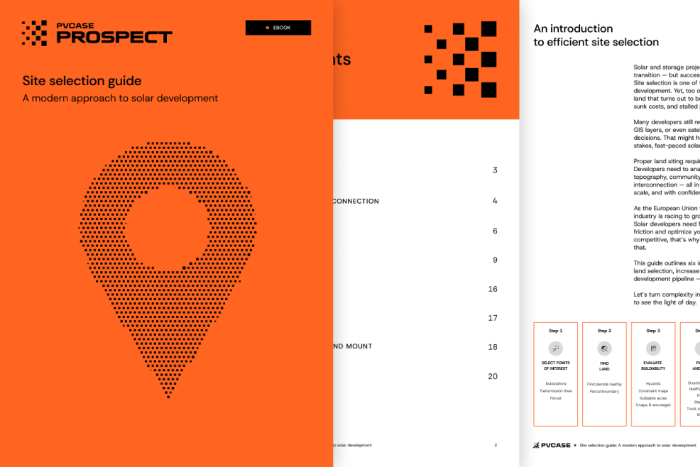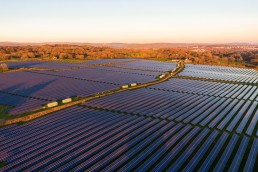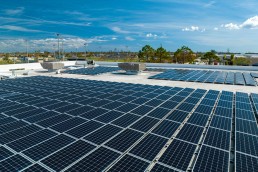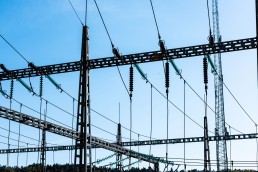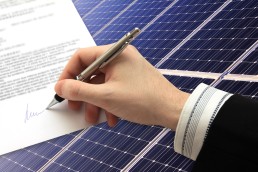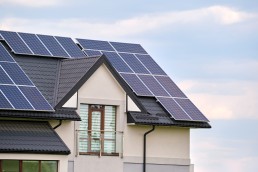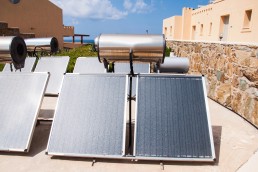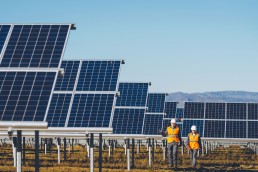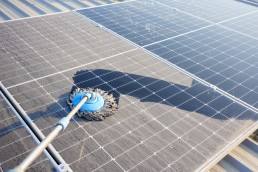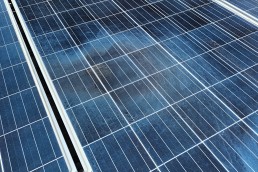Large-scale photovoltaic (PV) plants, sometimes spanning thousands of acres, generate hundreds of megawatts-hours (MWh) of electricity, enough to power hundreds of thousands of homes. According to the International Energy Agency (IEA), renewable energy, with solar PV as a key driver, is set to overtake coal and gas by the end of 2024.
However, the large-scale deployment of solar PV plants comes with its own set of challenges. Efficient and high-performing PV plants are essential to justify the substantial investments required. This efficiency is measured through various performance metrics, and addressing the factors that influence these metrics is critical for the success of these projects.
Obviously, successful deployment of large PV power plants requires addressing various challenges related to site selection, design, maintenance, and grid integration. Read on to find out how to overcome these challenges, ensure the long-term success of solar PV plants, and how PVcase can help.
Table of contents
Understanding PV plant performance
The performance of photovoltaic solar plants is evaluated using several key performance indicators (KPIs) that provide insights into their efficiency and reliability. Understanding these KPIs and the factors influencing them is crucial for optimizing the performance of solar energy plants.
Key performance indicators (KPIs)
Here are the main KPIs that relate to the performance of PV power plants:
- Capacity factor: the capacity factor measures the actual output of a solar power plant compared to its maximum potential output over a specific period. It is expressed as a percentage and indicates how effectively the plant converts available sunlight into electricity. A higher capacity factor signifies better performance and efficiency.
- Performance Ratio (PR): the performance ratio measures the quality of a PV plant and its ability to convert available sunlight into usable energy, taking into account all losses. It is expressed as a percentage and provides a comprehensive view of the system’s efficiency. A higher PR indicates a more efficient system.
- Levelized Cost of Energy (LCoE): LCoE is a critical economic metric that represents the average cost of generating electricity over the plant’s lifetime, considering all costs and energy produced. It is expressed in monetary units per kilowatt-hour (kWh). A lower LCoE indicates a more cost-effective solar panel power plant.
- Efficiency: efficiency refers to the ratio of electrical output to the solar energy received by the panels. It is influenced by factors such as panel technology, quality, and degradation over time. High-efficiency panels convert more sunlight into electricity, enhancing the overall performance of the solar plant.
- Availability: this KPI measures the proportion of time a solar power plant is operational and producing electricity. High availability is essential for maximizing energy production and achieving financial returns. Factors such as maintenance practices, equipment reliability, and grid connectivity impact the availability of a PV plant.
- Degradation rates: due to environmental exposure, solar panels gradually reduce their efficiency over time. Monitoring degradation rates helps in planning maintenance and replacements to sustain performance. Typically, solar panels degrade at a rate of 0.5% to 1% per year.
Factors influencing PV plant performance
Several factors influence the performance of solar PV plants, including:
- Location: the geographical location of a solar PV plant significantly affects its performance. Areas with high solar irradiance levels are ideal for maximizing energy generation. Factors such as latitude, altitude, and local climate conditions play crucial roles in determining the suitability of a location for a solar power plant.
- Design: the design of a PV plant, including the layout, orientation, and spacing of solar panels, is critical for optimizing sunlight capture and minimizing shading losses. Advanced solar design software tools and yield estimation software, such as those provided by PVcase, help engineers create efficient and effective solar plant designs.
- Operational practices: effective operations and maintenance (O&M) practices are essential for maintaining high performance. Regular cleaning of solar panels, timely repairs, and efficient monitoring systems contribute to the optimal operation of a solar PV plant. Predictive maintenance techniques using data analytics to forecast equipment failures can significantly enhance plant availability and reduce downtime.
In conclusion, by monitoring key performance indicators and addressing the factors influencing performance, solar energy plants can achieve their full potential and contribute significantly to the global transition to renewable energy.
Site selection and environmental considerations
The success of a large-scale solar PV plant begins with carefully selecting the site. Optimal site selection involves maximizing solar irradiance while minimizing shading and other obstacles. This process is crucial for ensuring that solar plants can operate efficiently and generate maximum electricity.
Importance of optimal site selection
Selecting the right site for a solar panel power plant involves several considerations:
- Solar irradiance: the amount of sunlight that reaches the site is the most critical factor. High solar irradiance levels translate to higher energy production.
- Land characteristics: the physical characteristics of the land, including slope, soil type, and elevation, affect the feasibility of constructing a solar PV plant. Flat or gently sloping land is ideal as it simplifies installation and minimizes shading. Ground grading is essential in this context to prepare the land for optimal panel installation.
- Proximity to the grid: the distance from the site to the nearest grid connection point impacts the cost and feasibility of integrating the solar plant into the electrical grid. Sites closer to grid infrastructure are preferred to reduce transmission losses and costs.
- Accessibility: easy access to the site for construction, maintenance, and operation is essential. Sites with good road connectivity and infrastructure support efficient project execution.
Environmental impact assessments
Environmental impact assessments (EIAs) are conducted to evaluate the potential effects of a solar PV plant on the local environment. These assessments help identify and mitigate negative impacts, ensuring that the development of the solar plant is sustainable.
- Biodiversity and wildlife: solar panel power plant can affect local ecosystems and wildlife habitats. EIAs identify sensitive areas and propose measures to protect biodiversity, such as creating buffer zones and wildlife corridors.
- Soil erosion and land use: solar installations can lead to soil erosion and changes in land use. Techniques such as terracing, vegetation cover, and erosion control measures, including solar site grading, are implemented to minimize these impacts.
Mitigation strategies
To ensure sustainable development, several mitigation strategies are employed during the planning and construction phases of solar PV plants:
- Habitat preservation: protecting and preserving natural habitats within and around the project site helps maintain biodiversity. This includes creating protected areas and avoiding critical habitats.
- Erosion control: implementing erosion control measures, such as planting cover crops and using geotextiles, helps stabilize the soil and prevent erosion during and after construction.
- Sustainable land management: adopting sustainable land management practices, such as agrivoltaics (combining agriculture and solar energy production), optimizes land use and benefits local communities.
Effective site selection and environmental planning enhance the performance of solar PV plants and ensure their long-term viability and acceptance by local communities.
Design and engineering challenges
Designing large-scale PV power plants involves addressing several engineering challenges to ensure optimal performance and efficiency.
- Terrain adaptation: PV plants are often built on diverse terrains, including flatlands, hills, and deserts. Each terrain type presents unique challenges that must be addressed to optimize performance. For instance, hilly terrains require careful planning to minimize shading and ensure even panel distribution.
- Climate considerations: different climates, such as arid deserts, humid tropics, and cold regions, affect the performance and longevity of solar panels. Dust and sand accumulation in deserts, humidity-induced corrosion in tropical areas, and snow cover in cold regions are some of the challenges that need specific design solutions.
Solutions for optimizing layout, orientation, and spacing
- Layout optimization: the arrangement of solar panels significantly impacts their efficiency. Techniques such as staggered rows, optimal tilt angles, and strategic spacing are used to maximize sunlight capture and minimize shading losses. Advanced solar design software tools, like PVcase Ground Mount, aid in creating optimal layouts that enhance performance.
- Orientation and tilt: the orientation and tilt of solar panels are adjusted based on the geographic location to capture maximum sunlight. For instance, in the northern hemisphere, panels are typically oriented towards the south to receive the most sunlight throughout the day.
- Spacing and shading: proper spacing between rows of panels prevents shading and allows for maintenance access. PVcase helps identify and mitigate shading issues, ensuring that each panel receives adequate sunlight.
Operational and maintenance strategies
Effective operations and maintenance (O&M) are crucial for sustaining the performance and longevity of photovoltaic solar plants.
Proper O&M practices ensure that the solar panels and associated equipment operate at peak efficiency, minimizing downtime and maximizing energy production.
Importance of effective O&M practices
- Sustaining performance: regular maintenance activities, such as cleaning solar panels and inspecting electrical connections, help sustain the performance of PV power plants.
- Reducing downtime: proactive O&M practices reduce the risk of unexpected equipment failures, ensuring high availability and reliability. This involves routine inspections, predictive maintenance, and timely repairs.
- Optimizing efficiency: efficient O&M practices optimize the performance of solar panels and other components, leading to higher energy yields and better financial returns. This includes optimizing inverter settings, monitoring performance metrics, and implementing data-driven maintenance strategies.
Common O&M challenges
- Soiling: dust, dirt, and debris accumulation on solar panels reduces efficiency. Soiling is a significant issue in arid and dusty regions. Regular cleaning schedules and innovative cleaning technologies, such as automated robotic cleaners, are used to mitigate soiling.
- Equipment failures: components like inverters, transformers, and trackers can fail. Predictive maintenance techniques, which use data analytics to forecast potential failures, can significantly reduce downtime and maintenance costs.
- Grid integration issues: integrating large-scale solar plants into the grid poses challenges such as voltage stability and intermittency. Advanced grid support technologies and demand response strategies help mitigate these issues.
While O&M causes significant challenges, proper construction significantly reduces the risk of bumping into O&M-related challenges.
Solutions for improving O&M
- Remote monitoring: remote monitoring systems use sensors and data analytics to track the performance of solar panels and associated equipment continuously.
- Predictive maintenance: using historical data and machine learning algorithms, predictive maintenance techniques forecast equipment failures before they occur.
- Automated cleaning systems: automated robotic cleaners and waterless cleaning technologies are being deployed to keep solar panels free from dust and debris.
- Advanced diagnostic tools: tools such as infrared thermography, aerial drone inspections, and electrical testing equipment are used to detect faults and inefficiencies in solar panels and electrical systems.
By implementing these advanced O&M strategies, PV plants can maintain high performance and reliability throughout their operational lifespan.
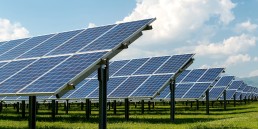
Grid integration and energy storage
Integrating large-scale PV plants into the electrical grid presents several challenges, primarily due to solar energy’s intermittent nature. Let’s have a closer look.
Challenges related to grid integration
- Intermittency: solar energy production is variable and depends on weather conditions and time of day. This intermittency challenges grid stability and reliability, as sudden fluctuations in solar output can affect grid operations.
- Voltage stability: large-scale integration of PV power plants can lead to voltage fluctuations in the grid. Maintaining voltage stability is crucial for preventing power quality issues and ensuring the smooth operation of electrical equipment.
- Grid congestion: high penetration of solar energy can lead to congestion in certain areas of the grid, affecting the distribution and transmission of electricity. Managing this congestion requires advanced grid management techniques and infrastructure upgrades.
Solutions for enhancing grid integration
- Advanced inverter technologies: modern inverters provide grid support functions such as voltage regulation, frequency control, and reactive power compensation.
- Demand response strategies: demand response involves adjusting the load on the grid in response to solar energy availability. This helps balance supply and demand, reducing the impact of solar intermittency on grid operations.
- Energy storage systems (ESS): Energy storage systems, such as batteries, store excess energy generated during peak sunlight hours and release it during periods of low solar production. This helps smooth out fluctuations in solar output and provides a reliable energy supply.
Role of energy storage systems
- Smoothing intermittency: ESS can absorb excess solar energy during periods of high production and discharge it during low production periods, thereby smoothing out the variability in solar output.
- Enhancing grid stability: by providing ancillary services such as frequency regulation and voltage support, ESS enhance grid stability and reliability.
- Supporting peak demand: ESS can supply electricity during peak demand periods, reducing the need for additional generation capacity. This not only enhances grid reliability but also reduces operational costs.
- Facilitating renewable integration: ESS enable higher penetration of renewable energy by providing the flexibility needed to manage variability and intermittency.
Advanced technologies and innovative solutions are crucial in enhancing grid stability and reliability, ensuring that solar energy can be effectively integrated into the existing energy infrastructure.
Financial and regulatory considerations
Large-scale solar PV plants’ financial viability and regulatory compliance are critical factors that influence their development and operation.
Understanding the economic challenges and navigating the regulatory landscape is essential for successfully deploying solar energy projects.
Economic challenges
- High initial capital costs: developing large-scale PV plants requires substantial upfront investment. Costs include land acquisition, equipment procurement, construction, and grid connection.
- Fluctuating energy prices: the volatility of energy prices affects the financial stability of solar PV projects.
Financial solutions
One of the best financial solutions in this case is Power purchase agreements (PPAs). PPAs are long-term contracts between a solar power producer and an electricity buyer. They provide revenue stability by securing fixed prices for the electricity generated over a specified period. PPAs are a common financing mechanism for large-scale solar projects, reducing financial risk and attracting investment.
Regulatory considerations
- Compliance with standards: PV power plants must comply with local, national, and international standards and regulations. These include technical standards for equipment, safety protocols, and environmental guidelines.
- Permitting and approvals: obtaining permits and approvals from relevant authorities is a critical step in the development of PV projects. This process involves environmental assessments, land use approvals, and grid connection permits.
- Grid connection requirements: complying with grid connection requirements is essential for integrating solar plants into the electrical grid.
How can PVcase help?
PVcase offers a suite of advanced solar software solutions designed to address the challenges faced by large-scale PV plants and ensure their optimal performance and efficiency.
PVcase Prospect
PVcase Prospect redefines scalable renewable site development with the best available interconnection and energy markets data, extensive land search, buildable area analysis, initial layouts, and portfolio management tools under one roof. This extensive fleet of features scales early-stage renewable energy development from end-to-end. It offers:
- Automated site selection: PVcase automates the site selection process, helping to identify optimal locations for solar plants by analyzing factors such as solar irradiance, land characteristics, and grid proximity.
- Automated Parcel Search: provides developers with the most extensive search capabilities available on any site selection platform, allowing to quickly filter parcels based on specific criteria and eliminate manual processes.
- Comprehensive data: gives access to more public and premium data layers than any competitor, including interconnection queues, grid capacity, LMP, climate-adjusted flood risk, and more.
- Integration with PVcase Ground Mount: PVcase Prospect seamlessly integrates with PVcase Ground Mount, allowing users to transition from site selection and analysis to detailed design and optimization in seconds. This integration streamlines the solar development workflow, enhancing efficiency and accuracy from initial site evaluation to project implementation.
PVcase Ground Mount
PVcase Ground Mount is an AutoCAD-based solar design software for utility-scale solar power plants. It enables solar engineers to reduce project costs, boost reliability, and improve solar plant performance. Key features include:
- Terrain-based PV layout generation: it automatically generates PV layouts tailored to specific terrains.
- Piling and Collision Analysis: identifies potential obstacles to help optimize and export piling data.
- Electrical Device Placement and 3D Cabling: enables precise placement of electrical components and comprehensive cabling visualization.
- Integrates with PVcase Prospect and PVcase Yield: seamlessly integrates with other industry-standard tools like Pvcase Prospect and PVcase Yield, enabling comprehensive project analysis and continuation of work across project phases.
PVcase Yield
PVcase Yield is a cloud-based energy modeling software for solar PV systems that enables solar engineers and developers to estimate the yield of PV power plants. Here’s what you get:
- Performance simulation: the software simulates the performance of PV power plants under various conditions, providing accurate energy yield estimates.
- Compatibility with PVcase Ground Mount: seamlessly integrates with 3D design elements from PVcase Ground Mount for comprehensive project optimization.
- Advanced Simulation Methods: it utilizes ray tracing optical simulation combined with physics-based thermal-electrical methodology for accurate performance estimations.
- Module-level resolution: provides thermal-electrical modeling at a module-level resolution, ensuring detailed and precise analysis.
- Physics-Based Loss Computation: computes losses using advanced physical models, enhancing the accuracy of energy production predictions.
You might also be interested in:
November 7, 2024
From hours to minutes. The role of automated solar design software in solar projects
Extended timelines, inefficiency, and many different tools for solar projects are things of past. With automated solar design software you can reduce 50% time spent on layout…
October 30, 2024
How to design PV systems on complex roofs?
Discover how to navigate roof complexities, conduct effective site assessments, and uncover best practices with PVcase Roof Mount software while designing on complex roofs.
October 25, 2024
Understanding the importance of siting with Capacity information
Find out what Capacity is, why it matters, and how PVcase offers solar developers a tool that makes a real difference in the siting process.
October 10, 2024
Net energy metering: how does it work and what are the benefits?
Learn about net metering, how it works and its benefits for renewable energy users and the grid.
October 9, 2024
Solar lease vs. buy: which is better?
Explore the benefits and drawbacks of leasing or owning solar panels to determine the best option for your renewable energy needs.
October 8, 2024
Solar energy vs. fossil fuels: what’s the difference?
Want to understand the differences between solar energy and fossil fuels? Explore the pros and cons, including their environmental impacts and financial considerations.
October 7, 2024
Is solar power truly renewable or nonrenewable?
Discover whether solar energy is considered renewable or nonrenewable and explore the benefits of solar power for a sustainable future.
October 6, 2024
Understanding on-grid solar systems. Powering homes and businesses
Find out how grid-tied solar systems work, their advantages and why they're popular for homeowners and businesses looking to harness solar energy efficiently.
October 4, 2024
Solar energy vs. wind energy. Pros and cons
Discover whether solar energy is considered renewable or nonrenewable and explore the benefits of solar power for a sustainable future.
October 3, 2024
Achieving household energy independence
Discover how energy independence through solar power can benefit your household, reduce costs, and contribute to a sustainable future.
October 2, 2024
Solar powered water heaters. A comprehensive guide to their value and efficiency
Many people in rural areas have difficulty accessing financial services, a problem exacerbated by energy insecurity. Solar power can help protect rural communities from energy…
October 1, 2024
Separating solar energy facts from fiction
Explore common solar energy myths and facts. Learn the truth about the efficiency, costs, and environmental impact of solar power in this guide.
September 30, 2024
Essential solar panel maintenance for peak performance
Learn key strategies for solar panel upkeep, from regular cleaning to performance monitoring. Maximize efficiency and extend system life.
September 27, 2024
Understanding smart power grid technology
Discover how smart grids modernize power systems, enhance efficiency and integrate renewable energy sources for a sustainable future.
September 26, 2024
Why do solar panels degrade?
How and why do solar panels degrade? Explore the factors contributing to their lifespan and what measures to take to extend it.

